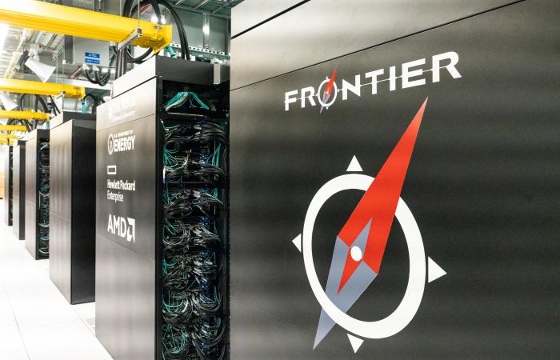 |
| June 07, 2022 | Volume 18 Issue 21 |
Designfax weekly eMagazine
Archives
Partners
Manufacturing Center
Product Spotlight
Modern Applications News
Metalworking Ideas For
Today's Job Shops
Tooling and Production
Strategies for large
metalworking plants
New world's fastest supercomputer breaks exascale barrier -- system built and run by U.S. Oak Ridge National Lab

[Photo credit: Carlos Jones/ORNL, U.S. Dept. of Energy]
The Frontier supercomputer at the Department of Energy's Oak Ridge National Laboratory (ORNL) earned the top ranking May 30, 2022, as the world's fastest on the 59th TOP500 list, with 1.1 exaflops of performance. The system is the first to achieve an unprecedented level of computing performance known as exascale, a threshold of a quintillion calculations per second.
Frontier features a theoretical peak performance of 2 exaflops, or two quintillion calculations per second, making it 10 times more powerful than ORNL's Summit system. The system leverages ORNL's extensive expertise in accelerated computing and will enable scientists to develop critically needed technologies for the country's energy, economic, and national security, helping researchers address problems of national importance that were impossible to solve just five years ago.
Rankings were announced at the International Supercomputing Conference 2022 in Hamburg, Germany, which gathers leaders from around the world in the field of high-performance computing, or HPC. Frontier's speeds surpassed those of any other supercomputer in the world, including ORNL's Summit, which is also housed at ORNL's Oak Ridge Leadership Computing Facility, a DOE Office of Science user facility.
Frontier, a HPE Cray EX supercomputer, also claimed the No. 1 spot on the Green500 list, which rates energy use and efficiency by commercially available supercomputing systems, with 62.68 gigaflops performance per watt. Frontier rounded out the twice-yearly rankings with the top spot in a newer category, mixed-precision computing, that rates performance in formats commonly used for artificial intelligence.
The work to deliver, install, and test Frontier began during the COVID-19 pandemic, as shutdowns around the world strained international supply chains. More than 100 members of a public-private team worked around the clock, from sourcing millions of components to ensuring deliveries of system parts on deadline to carefully installing and testing 74 HPE Cray EX supercomputer cabinets, which include more than 9,400 AMD-powered nodes and 90 miles of networking cables.
Frontier's overall performance of 1.1 exaflops translates to more than one quintillion floating point operations per second, or flops, as measured by the High-Performance Linpack Benchmark test. Each flop represents a possible calculation, such as addition, subtraction, multiplication, or division.
Frontier's early performance on the Linpack benchmark amounts to more than seven times that of Summit at 148.6 petaflops. Summit continues as an impressive, highly ranked workhorse machine for open science, listed at number four on the TOP500.
Frontier's mixed-precision computing performance clocked in at roughly 6.88 exaflops, or more than 6.8 quintillion flops per second, as measured by the High-Performance Linpack-Accelerator Introspection, or HPL-AI, test. The HPL-AI test measures calculation speeds in the computing formats typically used by the machine-learning methods that drive advances in artificial intelligence.
Detailed simulations relied on by traditional HPC users to model such phenomena as cancer cells, supernovas, the coronavirus, or the atomic structure of elements require 64-bit precision, a computationally demanding form of computing accuracy. Machine-learning algorithms typically require much less precision -- sometimes as little as 32-, 24-, or 16-bit accuracy -- and can take advantage of special hardware in the graphic processing units, or GPUs, relied on by machines like Frontier to reach even faster speeds.
ORNL and its partners continue to execute bringing Frontier up to total capabilities on schedule. Next steps include continued testing and validation of the system, which remains on track for final acceptance and early science access later in 2022 and open for full science at the beginning of 2023.
Fun facts about Frontier
The Frontier supercomputer's exascale performance is enabled by some of the world's most advanced pieces of technology from HPE and AMD:
- Frontier has 74 HPE Cray EX supercomputer cabinets that are purpose built to support next-gen supercomputing performance and scale, once open for early science access. Each cabinet weighs as much as a full-size pickup truck.
- Each node contains one optimized EPYC processor and four AMD Instinct accelerators, for a total of more than 9,400 CPUs and more than 37,000 GPUs in the entire system. These nodes provide developers with easier capabilities to program their applications due to the coherency enabled by the EPYC processors and Instinct accelerators.
- It uses HPE Slingshot, a high-performance Ethernet interconnect solution designed for next-gen HPC and AI solutions, including larger, data-intensive workloads, to address demands for higher speed and congestion control for applications to run smoothly and boost performance.
- An I/O subsystem from HPE will come online this year to support Frontier and the OLCF. The I/O subsystem features an in-system storage layer and Orion, a Lustre-based enhanced center-wide file system that is also the world's largest and fastest single parallel file system, based on the Cray ClusterStor E1000 storage system. The in-system storage layer will employ compute-node local storage devices connected via PCIe Gen4 links to provide peak read speeds of more than 75 TB/sec, peak write speeds of more than 35 TB/sec, and more than 15 billion random-read input/output operations/sec. The Orion center-wide file system will provide around 700 petabytes of storage capacity and peak write speeds of 5 TB/sec.
- As a next-generation supercomputing system and the world's fastest for open science, Frontier is also energy efficient due to its liquid-cooled capabilities. This cooling system promotes a quieter datacenter by removing the need for a noisier, air-cooled system. Six thousand gallons of water are moved through the system per minute by four 350-hp pumps, which could fill an Olympic-size swimming pool in 30 min.
Source: ORNL
Published June 2022
Rate this article
View our terms of use and privacy policy
